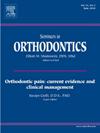III类患者磨牙倾斜横向自动矫正:使用III类腭板牵引上颌的病例分析
IF 2
4区 医学
Q2 DENTISTRY, ORAL SURGERY & MEDICINE
引用次数: 0
摘要
上颌横向缺陷是生长中的III类错颌患者的常见发现,下颌骨与上颌骨的相对位置导致了横向骨骼差异,通常伴随着矢状面和横向面的牙齿代偿。本病例系列研究了使用临时锚定装置(TAD)锚定的III类腭板在相对上颌横向缺陷患者中进行面中拉伸的影响。该系列强调了横向自动矫正的发生,特别是上颌磨牙倾斜的自发改善,在牵引后无需同时上颌扩张。探讨了上颌横缺的诊断要点和基于严重程度的鉴别诊断,以指导适当的治疗方法。本文讨论了自动矫正上颌横向差异的潜在机制,以及tad锚定上颌牵伸的生物力学优势。值得注意的是,本病例系列表明,上颌磨牙的倾斜在面中拉伸后自动纠正,提供了传统扩展技术的替代方案。这一系列病例的研究结果表明,上颌牵伸不扩张可能是生长中的III类患者相对上颌横向缺陷的可行治疗选择。然而,虽然这些初步观察结果很有希望,但需要进一步的对照临床试验来验证这种方法的有效性和长期稳定性。未来的研究对于确认这些结果和优化III类错颌横向差异的治疗方案至关重要。本文章由计算机程序翻译,如有差异,请以英文原文为准。
Transverse Autocorrection of molar inclination in Class III Patients: Case Insights on Maxillary Protraction Using Class III Palatal Plate
Maxillary transverse deficiency is a frequent finding in growing patients with Class III malocclusion, where the relative position of the mandible to the maxilla contributes to a transverse skeletal discrepancy, often accompanied by dental compensations in both the sagittal and transverse planes. This case series examines the impact of midfacial protraction using a temporary anchorage device (TAD)-anchored Class III palatal plate in patients with relative maxillary transverse deficiency. The series highlights the occurrence of transverse autocorrection, particularly the spontaneous improvement of maxillary molar inclination, following protraction without the need for concurrent maxillary expansion.
Key diagnostic considerations for maxillary transverse deficiency and the severity-based differential diagnosis are explored to guide the appropriate therapeutic approach. The potential mechanisms underlying the autocorrection of maxillary transverse discrepancies are discussed, alongside the biomechanical advantages of TAD-anchored maxillary protraction. Notably, this case series illustrates that the inclination of the maxillary molars corrected automatically after midfacial protraction, offering an alternative to conventional expansion techniques.
The findings from this case series suggest that maxillary protraction without expansion may be a viable treatment option for growing Class III patients with relative maxillary transverse deficiency. However, while these preliminary observations are promising, further controlled clinical trials are necessary to validate the efficacy and long-term stability of this approach. Future studies will be crucial in confirming these outcomes and optimizing protocols for the management of transverse discrepancies in Class III malocclusions.
求助全文
通过发布文献求助,成功后即可免费获取论文全文。
去求助
来源期刊

Seminars in Orthodontics
DENTISTRY, ORAL SURGERY & MEDICINE-
CiteScore
2.20
自引率
4.80%
发文量
28
审稿时长
10 days
期刊介绍:
Each issue provides up-to-date, state-of-the-art information on a single topic in orthodontics. Readers are kept abreast of the latest innovations, research findings, clinical applications and clinical methods. Collection of the issues will provide invaluable reference material for present and future review.
 求助内容:
求助内容: 应助结果提醒方式:
应助结果提醒方式:


